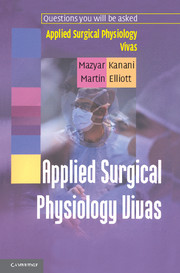Book contents
- Frontmatter
- Contents
- List of Abbreviations
- Dedication
- Preface
- A Change in Posture
- Acid-Base
- Action Potentials
- Adrenal Cortex I
- Adrenal Cortex II – Clinical Disorders
- Adrenal Medulla
- Arterial Pressure
- Autonomic Nervous System (ANS)
- Carbon Dioxide Transport
- Cardiac Cycle
- Cardiac Output (CO)
- Cell Signalling
- Cerebrospinal Fluid (CSF) and Cerebral Blood Flow
- Colon
- Control of Ventilation
- Coronary Circulation
- Fetal Circulation
- Glomerular Filtration and Renal Clearance
- Immobilization
- Liver
- Mechanics of Breathing I – Ventilation
- Mechanics of Breathing II – Respiratory Cycle
- Mechanics of Breathing III – Compliance and Elastance
- Mechanics of Breathing IV – Airway Resistance
- Microcirculation I
- Microcirculation II
- Micturition
- Motor Control
- Muscle I – Skeletal and Smooth Muscle
- Muscle II – Cardiac Muscle
- Nutrition: Basic Concepts
- Pancreas I – Endocrine Functions
- Pancreas II – Exocrine Functions
- Potassium Balance
- Proximal Tubule and Loop of Henle
- Pulmonary Blood Flow
- Renal Blood Flow (RBF)
- Respiratory Function Tests
- Small Intestine
- Sodium Balance
- Sodium and Water Balance
- Starvation
- Stomach I
- Stomach II – Applied Physiology
- Swallowing
- Synapses I – The Neuromuscular Junction (NMJ)
- Synapses II – Muscarinic Pharmacology
- Synapses III – Nicotinic Pharmacology
- Thyroid Gland
- Valsalva Manoeuvre
- Venous Pressure
- Ventilation/Perfusion Relationships
Autonomic Nervous System (ANS)
Published online by Cambridge University Press: 06 January 2010
- Frontmatter
- Contents
- List of Abbreviations
- Dedication
- Preface
- A Change in Posture
- Acid-Base
- Action Potentials
- Adrenal Cortex I
- Adrenal Cortex II – Clinical Disorders
- Adrenal Medulla
- Arterial Pressure
- Autonomic Nervous System (ANS)
- Carbon Dioxide Transport
- Cardiac Cycle
- Cardiac Output (CO)
- Cell Signalling
- Cerebrospinal Fluid (CSF) and Cerebral Blood Flow
- Colon
- Control of Ventilation
- Coronary Circulation
- Fetal Circulation
- Glomerular Filtration and Renal Clearance
- Immobilization
- Liver
- Mechanics of Breathing I – Ventilation
- Mechanics of Breathing II – Respiratory Cycle
- Mechanics of Breathing III – Compliance and Elastance
- Mechanics of Breathing IV – Airway Resistance
- Microcirculation I
- Microcirculation II
- Micturition
- Motor Control
- Muscle I – Skeletal and Smooth Muscle
- Muscle II – Cardiac Muscle
- Nutrition: Basic Concepts
- Pancreas I – Endocrine Functions
- Pancreas II – Exocrine Functions
- Potassium Balance
- Proximal Tubule and Loop of Henle
- Pulmonary Blood Flow
- Renal Blood Flow (RBF)
- Respiratory Function Tests
- Small Intestine
- Sodium Balance
- Sodium and Water Balance
- Starvation
- Stomach I
- Stomach II – Applied Physiology
- Swallowing
- Synapses I – The Neuromuscular Junction (NMJ)
- Synapses II – Muscarinic Pharmacology
- Synapses III – Nicotinic Pharmacology
- Thyroid Gland
- Valsalva Manoeuvre
- Venous Pressure
- Ventilation/Perfusion Relationships
Summary
1. What are the components of the ANS?
The sympathetic and parasympathetic nervous systems (SNS and PNS).
2. Where are the locations of the cell bodies of the neurones that make up the SNS?
Preganglionic cells: cell bodies are located at the lateral horns of the spinal grey matter. This extends from T1 to L2 (thoraco-lumbar outflow)
Postganglionic cells: cell bodies are located in the sympathetic chain
3. Other than their location, how else do pre and postganglionic cells of the SNS differ?
Preganglionic fibres are myelinated: therefore, their diameter is larger with more rapid transmission of the action potential
Differences in the neurotransmitter: the transmitter substance secreted by preganglionic cells is ACh (acting on nicotinic receptors), and by postganglionic cells is noradrenaline
4. What is special about the mode of sympathetic supply to the adrenal medulla?
The chromaffin cells of the adrenal medulla receive direct innervation from preganglionic sympathetic fibres arising from the lateral horn of the spinal cord. Stimulation leads to secretion of catacholamine from the chromaffin cells, so these cells are akin to postganglionic cells of the SNS.
5. How does the origin of the PNS differ from the SNS?
Preganglionic parasympathetic: these neurones take origin from specific cranial nerve nuclei and from sacral segments 2–4 of the spinal cord (cranio-sacral outflow vs. thoraco-lumbar origin of the SNS)
Parasympathetic ganglia: unlike the sympathetic chain, the PNS ganglia are located at discrete points close to their respective target organs
6. Which cranial nerves have a parasympathetic outflow?
- Type
- Chapter
- Information
- Applied Surgical Physiology Vivas , pp. 25 - 28Publisher: Cambridge University PressPrint publication year: 2004



